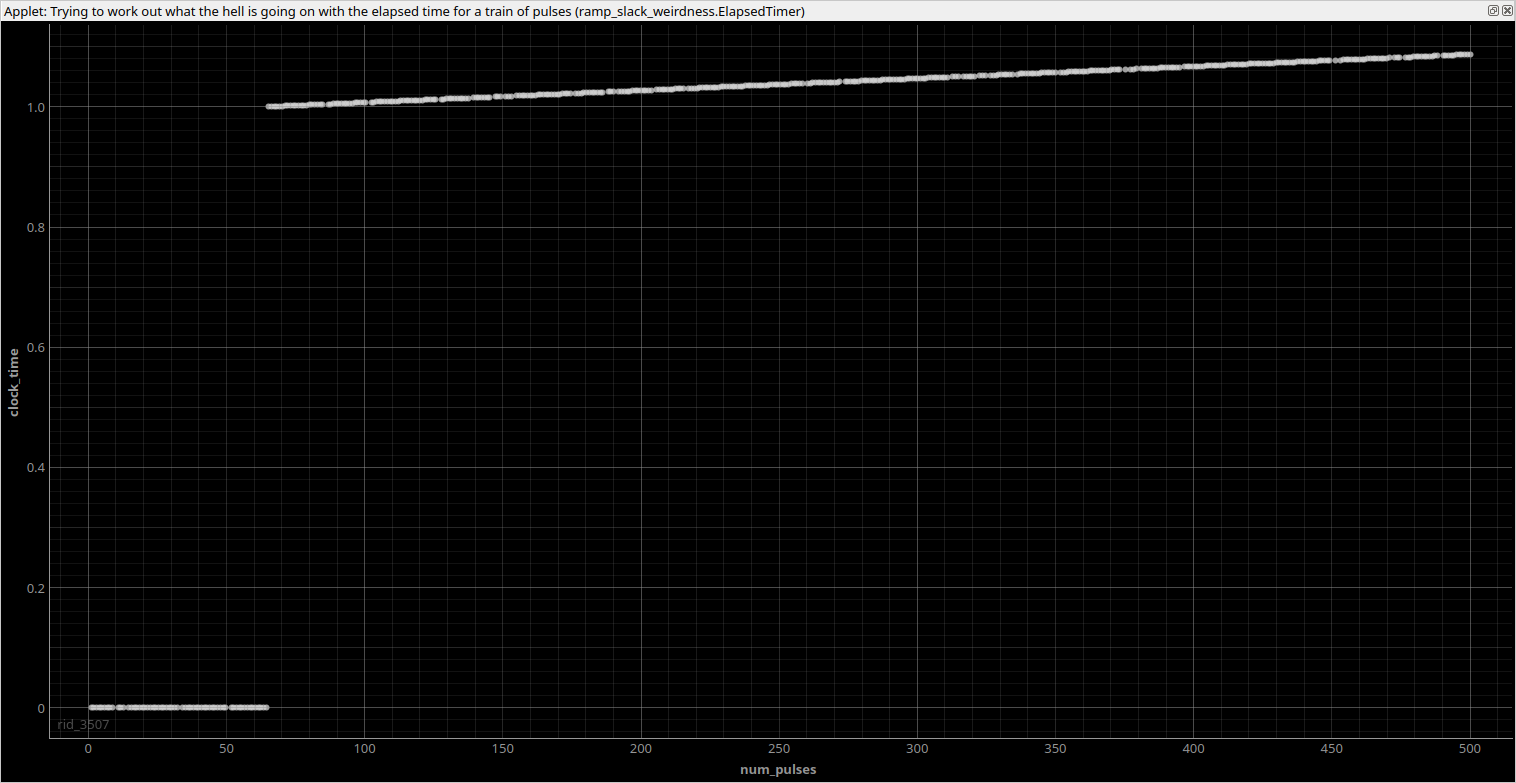- Edited
Hi,
I've run into some issues when trying to ramp the amplitude of a laser controlled by a SUServo. I'm submitting a relatively large number of steps for a controlled slope. However, when I have a large number of steps there appears to be a point beyond which all the slack is suddenly consumed.
Having investigated further, I've distilled it down to a simple example of just a train of N TTL pulses (see below). There are a couple of different behaviors I don't understand.
- Why is the slack suddenly consumed for large N?
This graph shows the consumed slack for number of pulses, with a jump at 65 pulses.

- Why does the critical value of N vary erratically with the number of TTLs being toggled?
1 TTL: 65
2 TTLs: 257
3 TTLs: 129
4 TTLs: 129
5 TTLs: 65
6 TTLs: 86
Ndscan:
class ElapsedTimer(ExpFragment):
def build_fragment(self):
self.setattr_device("core")
self.core: Core
self.ttl3: TTLInOut = self.get_device("ttl3")
self.ttl5: TTLInOut = self.get_device("ttl5")
self.ttl6: TTLInOut = self.get_device("ttl6")
self.ttl7: TTLInOut = self.get_device("ttl7")
self.ttl9: TTLInOut = self.get_device("ttl9")
self.ttl10: TTLInOut = self.get_device("ttl10")
self.ttl11: TTLInOut = self.get_device("ttl11")
self.setattr_result("clock_time")
self.setattr_param("num_pulses", IntParam, "num_pulses", 1000)
self.num_pulses: IntParam
@kernel
def run_once(self):
self.core.reset()
delay(1 * s)
start_rtio = self.core.get_rtio_counter_mu()
start_slack = now_mu() - start_rtio
for _ in range(self.num_pulses.get()):
with parallel:
# self.ttl3.pulse(duration=0.1 * ms)
# self.ttl5.pulse(duration=0.1 * ms)
# self.ttl6.pulse(duration=0.1 * ms)
# self.ttl7.pulse(duration=0.1 * ms)
self.ttl9.pulse(duration=0.1 * ms)
self.ttl10.pulse(duration=0.1 * ms)
self.ttl11.pulse(duration=0.1 * ms)
delay(0.1 * ms)
end_rtio = self.core.get_rtio_counter_mu()
end_slack = now_mu() - end_rtio
print(
"NDSCAN ELAPSED TIMER:",
self.num_pulses.get(),
"\nelapsed counter time",
self.core.mu_to_seconds(end_rtio - start_rtio) * 1000,
"ms\nelapsed slack time",
self.core.mu_to_seconds(end_slack - start_slack) * 1000,
"ms\nstart slack",
self.core.mu_to_seconds(start_slack) * 1000,
"ms\nend slack",
self.core.mu_to_seconds(end_slack) * 1000,
"ms",
)
self.clock_time.push(self.core.mu_to_seconds(end_rtio - start_rtio))
def get_default_analyses(self):
return [
OnlineFit(
"line",
data={
"x": self.num_pulses,
"y": self.clock_time,
},
),
]
ScanElapsedTime = make_fragment_scan_exp(ElapsedTimer)Pure Artiq:
class ElapsedTimer(EnvExperiment):
def build(self):
self.setattr_device("core")
self.core: Core
self.ttl10: TTLInOut = self.get_device("ttl10")
self.ttl11: TTLInOut = self.get_device("ttl11")
self.ttl9: TTLInOut = self.get_device("ttl9")
self.ttl3: TTLInOut = self.get_device("ttl3")
self.setattr_argument(
"num_pulses",
NumberValue(
default=1000,
precision=0,
scale=1,
step=1,
min=1,
max=10000,
type="int",
),
tooltip="Number of pulses to send",
)
@kernel
def run(self):
self.core.reset()
delay(1 * s)
start_rtio = self.core.get_rtio_counter_mu()
start_slack = now_mu()-start_rtio
for _ in range(self.num_pulses):
with parallel:
self.ttl3.pulse(duration=0.1 * ms)
self.ttl9.pulse(duration=0.1 * ms)
self.ttl10.pulse(duration=0.1 * ms)
self.ttl11.pulse(duration=0.1 * ms)
delay(0.1 * ms)
end_rtio = self.core.get_rtio_counter_mu()
end_slack = now_mu()-end_rtio
print(
"ELAPSED TIMER:",
self.num_pulses,
"\nelapsed counter time",
self.core.mu_to_seconds(end_rtio - start_rtio)*1000,
"ms\nelapsed slack time",
self.core.mu_to_seconds(end_slack-start_slack)*1000,
"ms\nstart slack",
self.core.mu_to_seconds(start_slack)*1000,
"ms\nend slack",
self.core.mu_to_seconds(end_slack)*1000,
"ms",
)